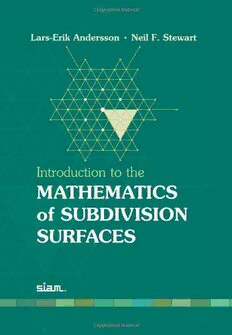Download Introduction to the mathematics of subdivision surfaces PDF Free - Full Version
Download Introduction to the mathematics of subdivision surfaces by Andersson L.E., Stewart N.F. in PDF format completely FREE. No registration required, no payment needed. Get instant access to this valuable resource on PDFdrive.to!
About Introduction to the mathematics of subdivision surfaces
Subdivision surfaces permit a designer to specify the approximate form of a surface defining an object and to refine and smooth the form to obtain a more useful or attractive version of the surface. A considerable amount of mathematical theory is required to understand the characteristics of the resulting surfaces, and this book provides a careful and rigorous presentation of the mathematics underlying subdivision surfaces as used in computer graphics and animation, explaining the concepts necessary to easily read the subdivision literature. It also organizes subdivision methods in a unique and unambiguous hierarchy in order to provide insight and understanding. The material is not restricted to questions related to regularity of subdivision surfaces at so-called extraordinary points but instead gives a broad discussion of the various methods. It is excellent preparation for reading more advanced texts that delve more deeply into special questions of regularity. The authors provide exercises and projects at the end of each chapter. Course material, including solutions to the exercises, is available on an associated Web page. Audience: This book is written for mathematically inclined Ph.D. students in computer science and researchers with advanced graduate-level expertise. Contents: List of Figures; List of Tables; Preface; Notation, Conventions, Abbreviations; Chapter 1: Introduction; Chapter 2: B-Spline Surfaces; Chapter 3: Box-Spline Surfaces; Chapter 4: Generalized-Spline Surfaces; Chapter 5: Convergence and Smoothness; Chapter 6: Evaluation and Estimation of Surfaces; Chapter 7: Shape Control; Appendix; Notes; Bibliography; Index
Detailed Information
| Author: | Andersson L.E., Stewart N.F. |
|---|---|
| Publication Year: | 2010 |
| ISBN: | 9780898716979 |
| Pages: | 382 |
| Language: | English |
| File Size: | 2.232 |
| Format: | |
| Price: | FREE |
Safe & Secure Download - No registration required
Why Choose PDFdrive for Your Free Introduction to the mathematics of subdivision surfaces Download?
- 100% Free: No hidden fees or subscriptions required for one book every day.
- No Registration: Immediate access is available without creating accounts for one book every day.
- Safe and Secure: Clean downloads without malware or viruses
- Multiple Formats: PDF, MOBI, Mpub,... optimized for all devices
- Educational Resource: Supporting knowledge sharing and learning
Frequently Asked Questions
Is it really free to download Introduction to the mathematics of subdivision surfaces PDF?
Yes, on https://PDFdrive.to you can download Introduction to the mathematics of subdivision surfaces by Andersson L.E., Stewart N.F. completely free. We don't require any payment, subscription, or registration to access this PDF file. For 3 books every day.
How can I read Introduction to the mathematics of subdivision surfaces on my mobile device?
After downloading Introduction to the mathematics of subdivision surfaces PDF, you can open it with any PDF reader app on your phone or tablet. We recommend using Adobe Acrobat Reader, Apple Books, or Google Play Books for the best reading experience.
Is this the full version of Introduction to the mathematics of subdivision surfaces?
Yes, this is the complete PDF version of Introduction to the mathematics of subdivision surfaces by Andersson L.E., Stewart N.F.. You will be able to read the entire content as in the printed version without missing any pages.
Is it legal to download Introduction to the mathematics of subdivision surfaces PDF for free?
https://PDFdrive.to provides links to free educational resources available online. We do not store any files on our servers. Please be aware of copyright laws in your country before downloading.
The materials shared are intended for research, educational, and personal use in accordance with fair use principles.

